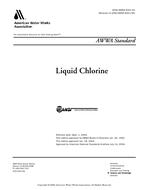Provide PDF Format
AWWA ACE95039
- Cost Saving Design for Wells
- Conference Proceeding by American Water Works Association, 01/01/1995
- Publisher: AWWA
$12.00$24.00
This paper describes the results of well research which is investigating ways to make water wells more efficient. Forty percent of the large utilities and over eighty percent of the smaller utilities obtain their water from aquifers. The major portion of their pumping costs comes from the operation of the water supply wells. Because there has been no major design change in water well construction and operation for decades, there may be ways to improve well design to reduce these pumping costs. There are three ways these costs can be reduced. First, size each well pumping system to deliver water at its optimal discharge. Second, implement an optimal replacement program. Third, optimally design each well. The first two ways are well known, but not always practiced. However, concerning the third way, research done by The University of Memphis and Memphis Light, Gas, and Water has shown that under normal design in a prolific aquifer, over half of the water entering the well screen enters in the top five percent of the screen. This, of course, means that the bottom ninety percent, or so, of the screen is hardly being used at all. Moreover, the entrance velocity of the water entering at the top of the screen may be twenty times greater than the velocity at the bottom of the screen. This may cause the well to be greatly over designed, or produce sand pumping or sand drive, hindering the well productivity. By merely extending the pump intake into the screen, the variations of flow along the screen can be greatly reduced. The theoretical equations suggest that the discharge capacity of the well is more sensitive to screen length than screen diameter. These findings indicate that screen diameter is much more important than traditionally realized. "Under reaming" has been another effective method to improve well design. Finally, installing a "flow equalizing device" on the pump intake can cause the flow along the screen to be uniform.
Related Products
AWWA JTMGT69629
From Sewer Pond to Southern Living: Titusville's Journey from Environmental Liability to Community A..
$12.00 $24.00
AWWA ACE92127
Physicochemical Aspects of Particle Motion in Crossflow Membrane Filters..
$12.00 $24.00
AWWA JAW22502
Journal AWWA - Discovery and Elimination of Dioxins From a Carbon Reactivation Process ..
$15.00 $30.00





